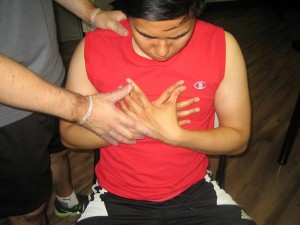Childhood asthma is a condition in which the lungs and airways are easily inflamed whenever exposed to airborne pollen. Sometimes, childhood asthma can flare up with a cold or other infection of the respiratory tract. Childhood asthma cannot be cured and it will continue into adulthood, but with the right treatment, the affected child can keep the symptoms under control and minimize damage to growing lungs. You can enroll in a course on first aid today to be prepared to manage this condition.
Symptoms of childhood asthma
- There is shortness of breath
- Frequent and intermitted coughing episodes
- A whistling or wheezing sound when exhaling and there is chest congestion and tightness
- Younger children tend to suffer from chest pain

Other symptoms of childhood asthma include the following:
- There are bouts of coughing or wheezing that becomes worse with respiratory infections like cold and flu.
- There is difficulty in sleeping caused by shortness of breath, coughing or wheezing.
- There is a delay of recovery or the development of bronchitis after having one of the respiratory infections
- There is difficulty in breathing that will minimize engagement in play or exercises.
- Fatigue caused by insufficient sleep.
Causes of childhood asthma
- Traits that are inherited
- Exposure to environmental factors such as cigarette smoke and other air pollutions
- Airway infections acquired at a very young age.
- An increased immune system sensitivity that will cause the lungs and airways to swell and produce mucus when exposed to common cold, exposure to pollutants such as smoke from tobacco, certain physical activities, changes in the weather or cold air and having an allergy to dust mites, pet dander, mold and pollen.
Treatment and home remedies
- Maintain a low humidity at home by using a dehumidifier in order to keep the air dry.
- Change the filters in the furnace and air conditioner and install a small-particle filter in the ventilation system.
- If the child is allergic to dander of pets, avoid pets with fur and feathers. Bathing and grooming the pets is required on a regular basis in order to minimize the amount of dander in the surroundings.
- Installing an air conditioner in a room helps minimize the amount of airborne pollen coming from trees, grasses and weeds that finds its way indoors. It also lowers humidity indoors and will minimize exposure of the child to dust mites. If no air conditioner available, close the windows during pollen season.
- Change beddings, curtains and carpets regularly. Use washable curtains and blinds.
- Clean the house regularly at least once a week in order to remove dust and allergens.
- If outside and asthma is worsened by cold and dry air, wear a face mask.
- Maintain the daily medication routine of the child.
- Let the child perform some regular exercises in order to minimize the symptoms and for the overall health of the child.
- Avoid getting overweight since it can make asthma worse.